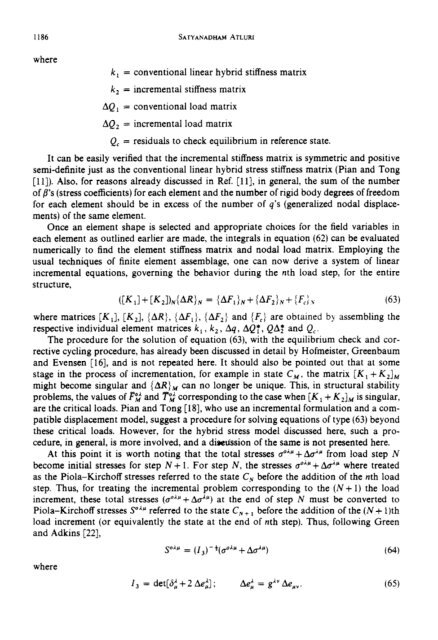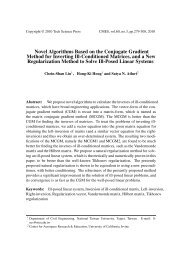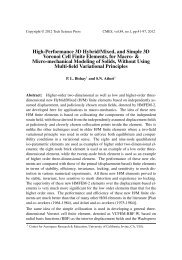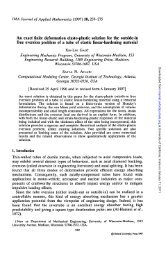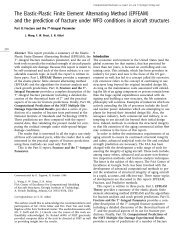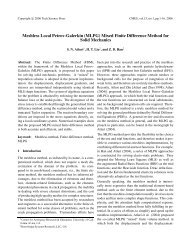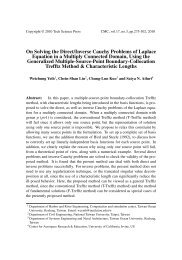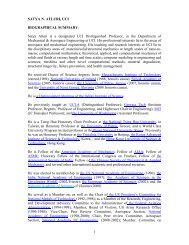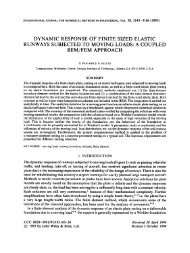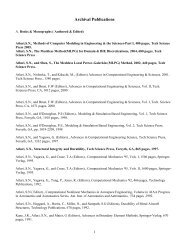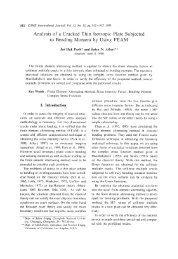on the hybrid stress finite element model for incremental analysis of ...
on the hybrid stress finite element model for incremental analysis of ...
on the hybrid stress finite element model for incremental analysis of ...
Create successful ePaper yourself
Turn your PDF publications into a flip-book with our unique Google optimized e-Paper software.
1186<br />
SATYANADUM ATLURI<br />
where<br />
k = c<strong>on</strong>venti<strong>on</strong>al<br />
k, = <strong>incremental</strong> stiffness matrix<br />
AQ1 = c<strong>on</strong>venti<strong>on</strong>al<br />
AQz = <strong>incremental</strong><br />
QC<br />
linear <strong>hybrid</strong> stiffness matrix<br />
load matrix<br />
load matrix<br />
= residuals to check equilibrium in reference state.<br />
It can be easily verified that <strong>the</strong> <strong>incremental</strong> stiffness matrix is symmetric and positive<br />
semi-de<strong>finite</strong> just as <strong>the</strong> c<strong>on</strong>venti<strong>on</strong>al linear <strong>hybrid</strong> <strong>stress</strong> stiffness matrix (Pian and T<strong>on</strong>g<br />
[ll]). Also, <strong>for</strong> reas<strong>on</strong>s already discussed in Ref. [ll], in general, <strong>the</strong> sum <strong>of</strong> <strong>the</strong> number<br />
<strong>of</strong> p’s (<strong>stress</strong> coefficients) <strong>for</strong> each <strong>element</strong> and <strong>the</strong> number <strong>of</strong> rigid body degrees <strong>of</strong> freedom<br />
<strong>for</strong> each <strong>element</strong> should be in excess <strong>of</strong> <strong>the</strong> number <strong>of</strong> q’s (generalized nodal displacements)<br />
<strong>of</strong> <strong>the</strong> same <strong>element</strong>.<br />
Once an <strong>element</strong> shape is selected and appropriate choices <strong>for</strong> <strong>the</strong> field variables in<br />
each <strong>element</strong> as outlined earlier are made, <strong>the</strong> integrals in equati<strong>on</strong> (62) can be evaluated<br />
numerically to find <strong>the</strong> <strong>element</strong> stiffness matrix and nodal load matrix. Employing <strong>the</strong><br />
usual techniques <strong>of</strong> <strong>finite</strong> <strong>element</strong> assemblage, <strong>on</strong>e can now derive a system <strong>of</strong> linear<br />
<strong>incremental</strong> equati<strong>on</strong>s, governing <strong>the</strong> behavior during <strong>the</strong> nth load step, <strong>for</strong> <strong>the</strong> entire<br />
structure,<br />
where matrices [K,], [KJ, {AR), {AF,}, {AF,) and {F,) are obtained by assembling <strong>the</strong><br />
respective individual <strong>element</strong> matrices k, , k, , Aq, AQ:, QA: and Q,.<br />
The procedure <strong>for</strong> <strong>the</strong> soluti<strong>on</strong> <strong>of</strong> equati<strong>on</strong> (63), with <strong>the</strong> equilibrium check and corrective<br />
cycling procedure, has already been discussed in detail by H<strong>of</strong>meister, Greenbaum<br />
and Evensen [16], and is not repeated here. It should also be pointed out that at some<br />
stage in <strong>the</strong> process <strong>of</strong> incrementati<strong>on</strong>, <strong>for</strong> example in state C,. <strong>the</strong> matrix [K, + K,],<br />
might become singular and {AR),,, can no l<strong>on</strong>ger be unique. This, in structural stability<br />
problems, <strong>the</strong> values <strong>of</strong> e$ and T”& corresp<strong>on</strong>ding to <strong>the</strong> case when [K 1 + K,], is singular,<br />
are <strong>the</strong> critical loads. Pian and T<strong>on</strong>g [18], who use an <strong>incremental</strong> <strong>for</strong>mulati<strong>on</strong> and a compatible<br />
displacement <strong>model</strong>, suggest a procedure <strong>for</strong> solving equati<strong>on</strong>s <strong>of</strong> type (63) bey<strong>on</strong>d<br />
<strong>the</strong>se critical loads. However, <strong>for</strong> <strong>the</strong> <strong>hybrid</strong> <strong>stress</strong> <strong>model</strong> discussed here, such a procedure,<br />
in general, is more involved, and a dioetissi<strong>on</strong> <strong>of</strong> <strong>the</strong> same is not presented here.<br />
At this point it is worth noting that <strong>the</strong> total <strong>stress</strong>es @‘+A&’ from load step N<br />
become initial <strong>stress</strong>es <strong>for</strong> step N f 1. For step N, <strong>the</strong> <strong>stress</strong>es oOlr + Aa”” where treated<br />
as <strong>the</strong> Piola-Kirch<strong>of</strong>f <strong>stress</strong>es referred to <strong>the</strong> state C, be<strong>for</strong>e <strong>the</strong> additi<strong>on</strong> <strong>of</strong> <strong>the</strong> nth load<br />
step. Thus, <strong>for</strong> treating <strong>the</strong> <strong>incremental</strong> problem corresp<strong>on</strong>ding to <strong>the</strong> (N + 1) <strong>the</strong> load<br />
increment, <strong>the</strong>se total <strong>stress</strong>es (c&J‘ +Aa*“) at <strong>the</strong> end <strong>of</strong> step N must be c<strong>on</strong>verted to<br />
Piola-Kirch<strong>of</strong>f <strong>stress</strong>es SoAr referred to <strong>the</strong> state C, + , be<strong>for</strong>e <strong>the</strong> additi<strong>on</strong> <strong>of</strong> <strong>the</strong> (N + 1 )th<br />
load increment (or equivalently <strong>the</strong> state at <strong>the</strong> end <strong>of</strong> nth step). Thus, following Green<br />
and Adkins [22],<br />
where<br />
S OAp = (1&- *(c+ + A&) (64)<br />
I, = det[GC + 2 Aei] ; Aei = g”’ Ae,,. (65)


